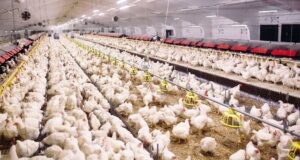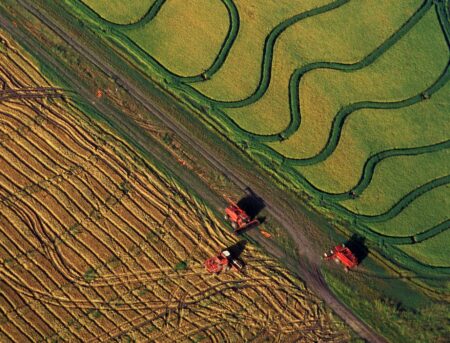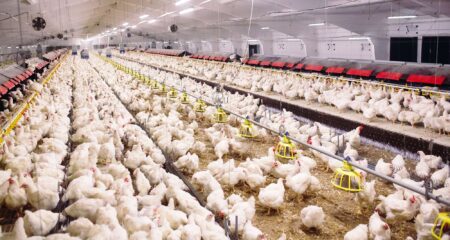By Boris Camiletti
Tar spot of corn, caused by the fungus Phyllachora maydis, has become one of the most challenging foliar diseases for corn growers in the Midwest. First identified in the U.S. in 2015, tar spot has spread rapidly, driven by favorable weather conditions and susceptible hybrids [1]. In Illinois, we have received multiple reports of tar spot in corn still in vegetative stages during the 2025 season, with confirmed cases across several counties. These early-season detections highlight the persistent nature of the disease and the importance of timely management.
Understanding Tar Spot: Symptoms and Disease Cycle
Tar spot typically appears as small, black, raised spots (stroma) on both the upper and lower surfaces of corn leaves. If viewed under the microscope, hundreds of sausage-shaped asci (spore cases) filled with spores are visible. When the infection is severe, the spots can merge and kill large sections of the leaf. This can cause the plant to dry down early and, in some cases, result in significant yield losses—up to 50 bushels per acre in susceptible hybrids [2]. In Illinois in 2024, yield losses due to tar spot were estimated at approximately 3%, translating to about a $29.75 per acre loss [3].
The disease is favored by cool, humid conditions, especially during extended periods of leaf wetness. The fungus overwinters on corn residue, and spores can be dispersed over long distances by wind. Once established, the disease can develop rapidly, particularly in dense canopies under wet conditions [4]. As we enter the critical reproductive stages of corn development, scouting and timely decision-making become essential.
New Tools for Real-Time Monitoring and Risk Assessment
To support farmers and agronomists in tracking disease outbreaks and planning fungicide applications, the Crop Protection Network (CPN) has launched two innovative tools: Crop Lookout and the Crop Disease Forecasting tool.
- Crop Lookout (Figure 1) is a real-time reporting platform where extension specialists and researchers across the U.S. and Canada contribute verified disease observations. The map allows users to see where diseases like tar spot, gray leaf spot, and southern rust have been confirmed, helping to guide local scouting and management decisions.
- The Crop Disease Forecasting (Figure 2) tool uses weather data and disease models to estimate the risk of disease development in your area. This interactive tool provides risk predictions to supports informed decisions about fungicide applications.
- The Corn Fungicide ROI Calculator helps estimate the economic return of a fungicide application by incorporating factors such as expected yield, corn price, and application costs. Simulations are based on end-of-season disease severity, with “Low” representing 1% severity and “High” representing 5% or greater. The tool is built using data from university uniform corn fungicide trials conducted between 2019 and 2022, including trials from Illinois. Tar spot and southern rust were the primary diseases. This tool is especially helpful when weighing the potential financial value of fungicide use under different disease pressure scenarios.
These tools are free and mobile-friendly, helping users make informed, timely decisions during the growing season.
farmdoc
farmdoc
The Crop Disease Forecasting Tool showed a sustained period of high risk for tar spot in the area around Monmouth, IL through late June (Figure 2). Similar risk patterns were also observed in other locations in north-central Illinois, which aligns with the timing of confirmed reports we received across several counties. However, the tool now shows a sharp decline in tar spot risk for early July. This highlights the importance of monitoring disease risk in real time to guide scouting efforts and inform fungicide application decisions.
Management Strategies for Tar Spot
Managing tar spot requires an integrated approach:
- Hybrid selection: Some hybrids exhibit partial resistance to tar spot. While not immune, these hybrids may slow disease progression and reduce yield loss.
- Fungicide application: Timely application of fungicides with multiple modes of action between the VT and R3 stages has been shown to reduce disease severity and protect yield [5]. If tar spot is not observed until R3, the application can be delayed until then, and a second spray is typically not needed (Table 1). For information on the efficacy of specific fungicides against tar spot and other foliar diseases, growers can consult the Fungicide Efficacy for Control of Corn Foliar Diseases table available through the Crop Protection Network.
- Residue management: While tillage may reduce local inoculum, the regional movement of spores means residue management alone is not a sufficient strategy.
farmdoc
Looking Beyond Tar Spot
Although this article focuses on tar spot, both Crop Lookout and the Crop Disease Risk Tool are designed to support the management of a wide range of diseases affecting row crops. By combining local observations with predictive models, these tools empower farmers and advisors to make more precise crop protection decisions.
Tar Spot on the Move: Tracking and Managing an Established Corn Threat in Illinois was originally published by Farmdoc.


:max_bytes(150000):strip_icc()/Canadian20flag48553671412_aeb0538794_c-0bfa123de2b54e30ab4fadecae382d4a.jpg)




:max_bytes(150000):strip_icc()/Screenshot2025-07-07at4.10.52PM-9661e4757040401791a783fd6ba11d41.png)


:max_bytes(150000):strip_icc()/WheatField-CloseUp-2000-bc79406da4004a2d94bcb2c32153cc3a.jpg)
:max_bytes(150000):strip_icc()/7020544KaronOlsoninshopoffice_preview-a3eff2b1e1aa4f819cb28d5eec1cac8a.jpg)
